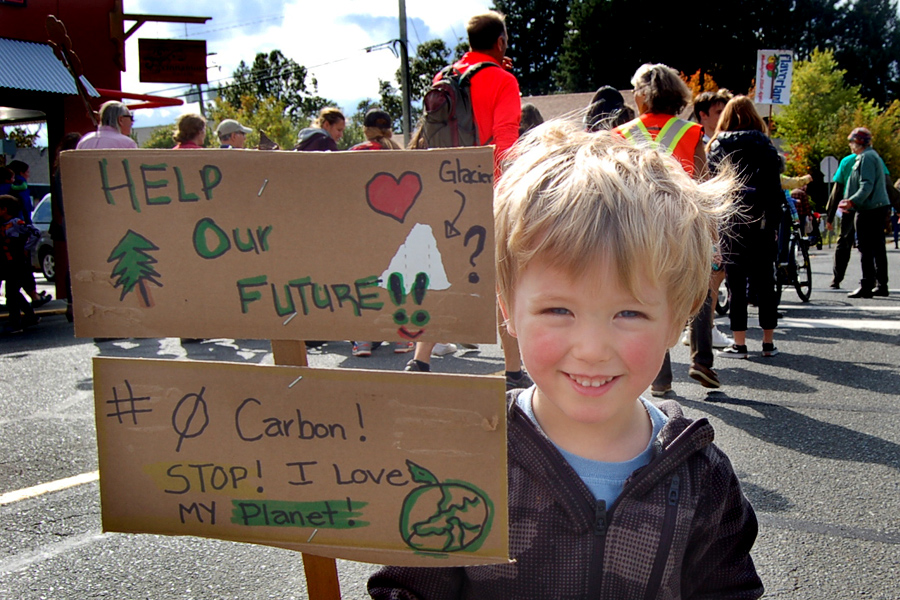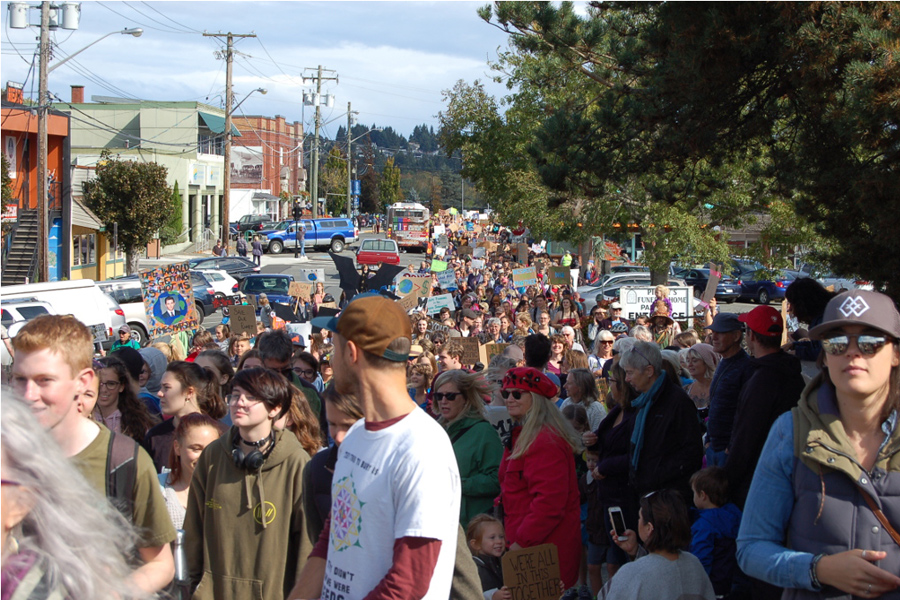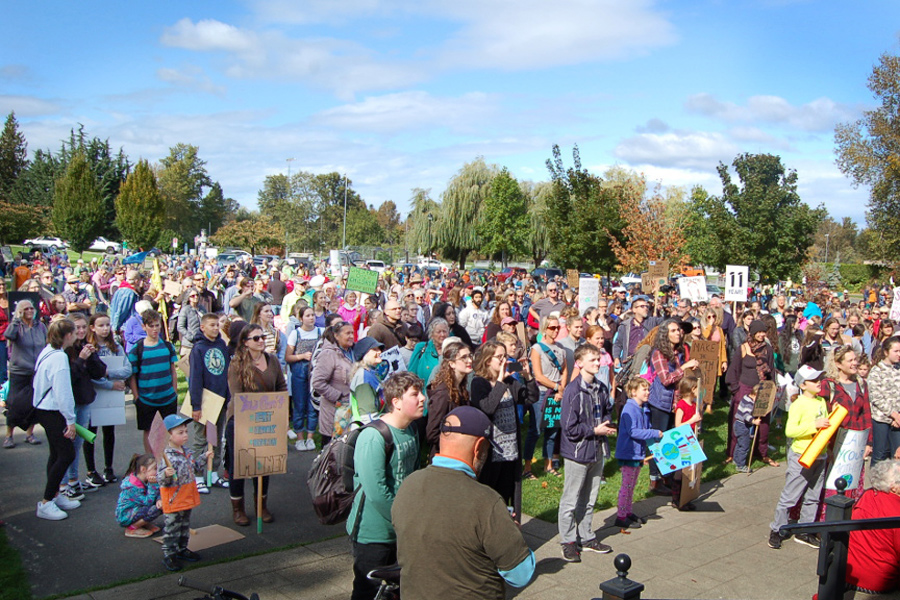Regional district staff recommend approving an amended application for groundwater extraction in Merville as a “home occupation,” but rural area directors want more clarity on its legal definition

Cycling has boomed during the pandemic, but do we have the infrastructure to make it safe?
Victoria has the best cycling infrastructure in BC | Adrian Williams photo, Upsplash
Cycling has boomed during the pandemic, but do we have the infrastructure to make it safe?
Maybe it’s a close call at an intersection, a stretch of winding road thick with distracted rush-hour drivers, or a painted bike lane that dies into a busy turning lane. Whatever it is, it feels sketchy, dissuades you from getting around by bike, and certainly doesn’t meet the CleanBC mandate for active transportation being “safe, easy, and convenient.”
 Safe, easy, and convenient is what you get with proper, modern cycling infrastructure. Without it, “people are driving places that normally they could easily walk or bike. That tells you that the streets don’t feel safe,” says Kay Teschke, professor emeritus at the UBC’s School of Population and Public Health. “People feel they have to encase themselves in a metal box to go ridiculously short distances.”
Safe, easy, and convenient is what you get with proper, modern cycling infrastructure. Without it, “people are driving places that normally they could easily walk or bike. That tells you that the streets don’t feel safe,” says Kay Teschke, professor emeritus at the UBC’s School of Population and Public Health. “People feel they have to encase themselves in a metal box to go ridiculously short distances.”
And with the COVID-19 pandemic prompting more people to choose pedal power over public transit and ridesharing services, cycling infrastructure is more important than ever.
So what infrastructure is safest for bikes (and e-bikes and mobility scooters), and how do you get it?
Is it safe?
Unsurprisingly, cyclists generally choose to ride routes that aren’t shared with motor vehicles. Research co-authored by Teschke found that cyclists and potential cyclists in Vancouver preferred to ride off-street bike paths or physically separated bike routes, and avoided riding on major streets or rural roads alongside moving traffic.
A second study by Teschke and others bears out this wisdom. Surveying 690 adults injured in cycling accidents in Toronto and Vancouver revealed that the type of cycling infrastructure can affect the risk of cycling injury up to 10-fold.
Off-street bike paths and dedicated, protected bike lanes alongside streets offered the safest ways to get around. The least safe routes were major streets without bike lanes and with parked cars, and major streets with “sharrows” – signs painted on the asphalt urging cars to share the road. Major streets with painted bike lanes stuffed between moving and parked cars were also risky, as were routes with major intersections, construction and train tracks.
“People need to ask: Would you ride [the route] with your 5- to 15-year-old?”
Speed, of course, was a huge factor as well. Intersections with traffic speeds over 30km/hr were more dangerous.
Cyclists’ perception of risks were usually correct, but the exception was multi-use paths – although preferred routes, they’re not particularly safe. However, Teschke says installing good night-lighting, reducing obstacles such as bollards, and straightening out unnecessarily curved pathways can go a long way to reduce the risk of injury.
The study found that just over three-quarters of the trips that resulted in injury were on weekdays, most were less than five kilometres long, and nearly three-quarters were collisions with motor vehicles, route features, people, or animals.
The take-home: if a cycling route doesn’t feel safe, that’s often because it isn’t.
“People need to ask: Would you ride [the route] with your 5- to 15-year-old?” Teschke says.
Another way to gauge the safety of cycling routes is with rider counts. Tell-tales signs of high-risk routes are a high percentage of male riders or the absence of parents with kids.
“If you’ve got cycling infrastructure that no one’s using, or if the predominant group who’s using it are adult males, you know that’s not safe cycling infrastructure,” Teschke says.
A special case is “paths to nowhere” – routes that can be safe but don’t see much traffic because they don’t connect to a larger cycling network that gets people where they need to go. This can be a problem for cities trying to grow their riding networks incrementally, Teschke says.
“If cycling infrastructure is not connected, every time there’s a break in the great infrastructure, that’s a no-go for many many people.”
Bikemaps.org is another tool to track cycling trouble spots. The free website lets users report and track collisions, near misses, hazards, bike thefts, and new cycling infrastructure on a global map.
Data from the exercise tracking service Strava is included, which helps to pinpoint where routes are risky or inconvenient enough to cause riders to detour. Bikemaps.org was founded by former UVic researcher Dr. Trisalyn Nelson and is maintained by a team of Canadian and American academics.
Comox Valley Cycling Coalition
Advocacy
So the bicycle commute to work or school, or trips to the grocery store could be safer. Now what?
A good start is to see if there is a cycling advocacy organization representing your community, and join it, says Colin Stein, executive director of the BC Cycling Coalition, an umbrella organization for nearly two dozen such groups. Cycling organizations, whether formal or not, can speak with a larger voice to command greater attention from local elected officials and staff, Stein says.
“One of the groups’ agenda items often is problem areas – gaps in routes, danger that needs to be addressed. People will pour on the anecdotes and bring photos and correlate with data from ICBC to show that this is a priority…. [Municipalities] rely on feedback from the cycling groups because it represents some of the richest data they can get … they take it seriously.”
A phone call, email, or letter to a mayor, councillor or to transportation planning staff should include three elements: a clear description of the problem, the requested change, and an inquiry as to what the next steps are.
Even with strength in numbers, there’s no magic formula to advocate for cycling infrastructure, but Teschke and Stein say it boils down to winning over municipal politicians and the staff in charge of transportation planning.
Both elected officials and staff are usually sincere in their pursuit of expanding active transportation, Stein says, and diplomacy and respect are the rule.
(Victoria is considered the clear leader in cycling infrastructure in BC, with the highest percentage of trips by bike in all of Canada. It’s such a cycling utopia that Teschke urges transportation planners from elsewhere in BC to visit in person and talk to the crack team in Victoria’s transportation planning department.)
A phone call, email, or letter to a mayor, councillor, or to transportation planning staff should include three elements, Stein says a clear description of the problem, the requested change, and an inquiry as to what the next steps are.
“Despite the cynicism that many people may find with their local government, elected officials and staff are there to make things better,” Stein says.
And good cycling infrastructure makes things better in many ways. Regular bike riders enjoy huge physical and mental health benefits, including a significant reduction in the likelihood of developing cancer, heart disease and diabetes – saving the Canadian health care system many millions of dollars each year.
Every trip by bike also displaces car traffic, air pollution, greenhouse gas emissions, and microplastic pollution from car tires.
Cycling infrastructure has economic benefits as well, with people travelling by bike shopping more frequently and spending more at local businesses, while proximity to cycling paths has been shown to boost property values.
According to a 2004 study from Norway’s Institute of Transport Economics, every dollar spent on cycling infrastructure can yield a 400-500 percent return.
The myriad benefits can build a solid case that overcomes cost considerations, Stein says.
“Stay on that argument – link it into equity issues, accessibility issues, environmental issues and even economic development issues …. Raise these issues to the forefront and say it’s not good enough to say ‘we don’t have enough money,’ because there are all these other factors we have to consider. That’s what can kill the financial argument [against cycling infrastructure].”
Cities and towns do get financial help from the province through the Active Transportation Infrastructure Grants program, which matches spending with municipalities for chosen “shovel ready” cycling infrastructure projects. In 2020-21 the grants totalled $9 million for 23 projects throughout BC.
That’s great, Teschke says, but at less than $2 per British Columbian, “The province needs to step up and put up a lot more money.”
Teschke suggests that considering 2.5 percent of trips in BC are made by bike, 2.5 percent of the province’s transportation budget might make a suitable baseline for cycling infrastructure spending.
Moving forward, Stein says it’s up to the province to take a far greater role. Planning and funding cycling infrastructure holistically would avoid a fragmented patchwork of safe bike routes separated by Ministry of Transport and Infrastructure roads that lack accommodations for cyclists.
“When you have municipalities with very limited funds, they can only build within their jurisdictions. That’s when you get the bike lane to nowhere, you get the big gaps, and that’s what turns people off cycling. So really the leader needs to be the province.”
But Stein says that in many jurisdictions in BC, politicians, planners, and engineers now understand the shifts that need to be made in favour of active transportation, and have the willingness to plan and build accordingly.
“After decades of struggle, this is starting to become a more popular – dare I say populist – issue, especially with e-bikes being such a game-changer for so many people,” Stein says. “So don’t hold back – write those letters, make those phone calls, send those emails. It really does make a difference.”
For more information: BC Cycling Coalition
OBJECTIVES OF THE CV CYCLING COALITION
— Promote the integration of cycling into the local and regional transportation network by upgrading the existing road and highway network, developing an interconnected system of cycling routes, and ensure all new developments provide safe and convenient cycling infrastructure.
— Promote cycling education for children and adults and cycling safety and awareness among cyclists as well as non-cycling road users.
— Promote the integration of cycling with other non-automotive modes of transportation, such as public transit, rail and regional bus transportation, walking and innovative low impact transportation systems (electric bicycles and scooters, etc.)
SUBSCRIBE TO OUR NEWSLETTER
On Merville groundwater extraction it’s deja vu all over again
Merville water bottling issue returns to the CVRD, highlights provincial water policies
The Comox Valley Electoral Areas Service Commission will consider on Monday an amended application for water bottling operations in Merville and draw attention to larger water policy issues in British Columbia
What’s dire: the lack of Comox subdivisions or climate change and gradual deforestation?
A Comox Valley developer is suing the Town of Comox because his permits to cut down trees and build more single-family homes haven’t been issued as fast as he’s wanted and because the town wants a wider walking trail through the property
Join the discussion Oct. 3 about food system security in the Comox Valley
The Watershed Sentinel magazine is hosting a zoom webinar Oct. 3 on food system security in the Comox Valley
Comox Valley Nature webinar to discuss effect of climate change on marine life
Comox Valley Nature lecture to discuss how this summer’s heatwave killed off billions of sea life and the future for marine ecosystems
New North Island organics processing facility raises concerns about cost, fire and odours
Campbell River environmentalists raise concerns about the the cost and location of the Comox Strathcona Waste Management Commission’s new organics processing facility
THE WEEK: 5 things wrong with how Comox tried to hide sewage spill information
Comox Town Council has nothing to say about raw sewage leaking into Brooklyn Creek beyond issuing a press release, which makes misleading statements
Tonnes of sewage mud removed from Brooklyn Creek, nearby residents say its been piling up for years
A Town of Comox infrastructure failure could have spilled raw sewage into Brooklyn Creek for a long time, according to nearby residents who have noticed unusual plant growth and sewage-type odours for nearly 24 months. Mayor and councilors say they didn’t know about it
Town of Comox spills raw sewage into Brooklyn Creek, doesn’t inform public
A broken pipe has spilled raw sewage into Brooklyn Creek and it appears that efforts to mitigate the damage have created a high level of turbidity, a double whammy for fish as well as a potential public health concern. But the Town of Comox has not yet formally informed the public.
Campbell River Environmental Committee lists its current top priorities
The Campbell River Environmental Committee has kept North Island residents aware of environmental risks and promoted awareness of potential concerns to help government and industry make informed decisions














